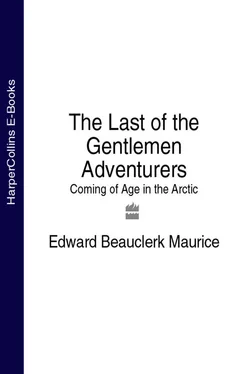The desolation of the little graveyard seemed in keeping with this island of grim black rock, and fitting for the final resting place of the people who had led such a hard and comfortless life.
In this area of Baffin Island, the Eskimos had been in contact with English and American sailors for seventy or eighty years. Cumberland Gulf had attracted the early whalers as a suitable base from which to hunt, and there is no doubt that the impact of these hardy men, with their new equipment for hunting, was very considerable indeed.
Previously, the people had been stuck in a more or less Stone Age period of development, caused not by lack of enterprise but rather by the harsh nature of their existence. The materials for making more efficient weapons were not obtainable in their country, while the climate was unsuitable for food production. The simplest fluctuation of conditions could mean the difference between life and death, for they had no means of controlling the variations of wind and weather.
With such implements as they had, they developed an art in hunting and a patience in enduring, without which they could not have survived. To these men, with such rudimentary possessions, the first whaling ships must have appeared as veritable Aladdin’s caves of undreamed of treasure. The knives of steel. The guns that thundered death so fast that the eye could not follow. The little sticks that gave a flame. The pots and pans. The food that was not meat or fat or fish. The cloth and clothing not made of furs or skins. There was no end to the wonders of these ships, for nearly everything they used was new to the Eskimo people.
Very gradually life became a mixture of the Stone Age and the modern. The new equipment cost money, more than most people had from work or trade. First of all, the lance and bow gave way to the rifle, but the whalers had nothing to improve upon the lamps that the Eskimos had always used, nor did the homes of skin or snow give way to wood or canvas for many decades, though only in the most distant and remote places do the people still use the skin tent and snowhouse today.
Without crops of any kind to give them flour or cereals, the Eskimos depended entirely upon being able to kill the wildlife of the country for food. By far the most important single item was seal meat, raw, boiled or frozen, fresh, high or putrid, it mattered not. Every particle of the seal except the bones was utilized. The skins for clothing or tent making, the fat for heating or cooking and the meat for food.
According to the season or place, other food was sometimes available. Fish from the river, sea and lakes. Ducks and geese. Walrus and polar bears, though the dangers of hunting either of these powerful antagonists without a rifle were considerable, and from the stories of the old days, it was certain that few hunters of any account did not have some scar from an encounter with a polar bear.
To the limited food variety, the whalers at once added flour, and though the people could not always afford to buy it in the early days, it came high on their list when they had anything with which to trade. Tobacco also became a much sought-after item of trade for both men and women.
Unhappily, in those days the sailors brought disease as well, in particular tuberculosis. There does not appear to be any record as to when this illness developed among the people of the Arctic. Explorers of the mid nineteenth century speak of them as suffering from the ‘bleeding sickness’. The only certain thing is that the first germs were brought in by the men who came from the south.
Nowadays the scourge has been brought under control, but in the days before the Second World War, the Eskimos had no defence against its ravages. Circumstances were such that a family of five or six had to exist closely together in the very restricted space of a tent or snowhouse, without cleanliness or hygiene. They used the same drinking vessels and spat thoughtlessly on the floor of their homes.
Once introduced, the disease spread steadily, even in this land where habitations were so widely separated, for it required only one hunter to travel further afield than usual for the plague to infect a new community, until there was hardly a family on Baffin Island that did not have at least one sufferer.
We did not wake early the next morning, perhaps because we had not really expected the wind to have dropped sufficiently to enable us to cross the remaining stretches of open water, so we had a pleasant surprise when Beevee returned from a morning inspection of the conditions. He told us that the weather was calm enough for us to resume our journey.
We bustled about to get everything ready for departure, though it turned out that we need not have hurried ourselves, for as we came down the short track to the boat we saw that the bow was resting firmly on the shore. The craft was so tightly aground that all our efforts to free it were unavailing. There was nothing for it but to sit and wait until the tide rose high enough to float the boat off again. The Eskimos had developed the virtue of patience to a degree seldom seen among Europeans. No doubt this was forced upon them by necessity, for in a world where survival is difficult enough, even with the help of the rifle, hunting success often came only after long endurance.
The Eskimos came also to possess a shell of resignation, enabling them to suffer, with apparent equanimity, any hardships that might arise. This resignation often became a source of irritation between them and their southern companions when hunting or travelling together, for in such a situation as we now found ourselves, with a shrug of the shoulders the Eskimo would say, ‘Ionamut’ (‘It can’t be helped’), and settle down to wait, while his companions become increasingly agitated.
Although the sun had come out the wait seemed interminable, but at last the tide did come up, the boat floated free and we set off on the second part of our journey. As we had lost half of the day, we did not attempt to reach home in one go, aiming instead for an inlet within range of an afternoon’s travel where some of Beevee’s relations lived.
This was the first real Eskimo encampment that I had encountered. We rounded a headland quite suddenly to reveal twenty-odd tents perched precariously on a narrow strip of flat underneath a very solid-looking cliff – the first consideration in selecting a campsite of course being for the people to place themselves as conveniently as possible for hunting purposes. Just down below the flat was a small, well-sheltered cove, on the shores of which the men had beached their kayaks. The skin tents, the summer homes, were of varying sizes but of the same general design as those in use all over the Arctic at that time, not only along the coastline, but also in the occasional areas where the Innuit were inland dwellers.
As Kilabuk had told me, the skins had been treated to reduce bulk and to allow as much light as possible to penetrate through, though in some cases the seal intestine, of near transparency, had been used as a window let into the skins. At this time the homes were mainly of two kinds. The first, by far the larger, had a long ridge pole down the centre with supports at either end, while the other was obviously suited to poorer hunters, who would not have had either enough skins for a larger dwelling, or enough fat to keep such a home warm. This second lot was of a conical style, rather like an Indian teepee, but not very roomy inside.
We made for the largest home in the middle of the camp, but coming so quickly in from the fresh air, the smell nearly overpowered me, compounded as it was of a strong mixture of decomposing meat and unwashed bodies. Had I not feared to offend my welcoming hosts, I would have asked Kilabuk and Beevee to set up our tent somewhere on the edge of the camp. In fact, as I discovered later, the curious actions of the kudloonas seldom offend the Eskimo, who has learned to accept the peculiarities of the strangers’ conduct.
Читать дальше












